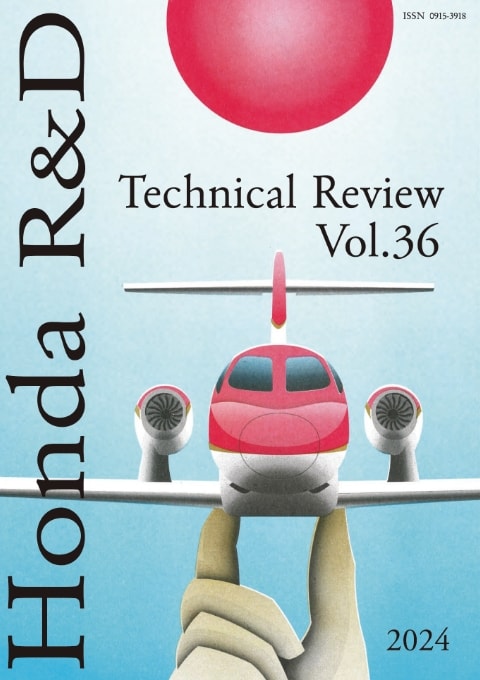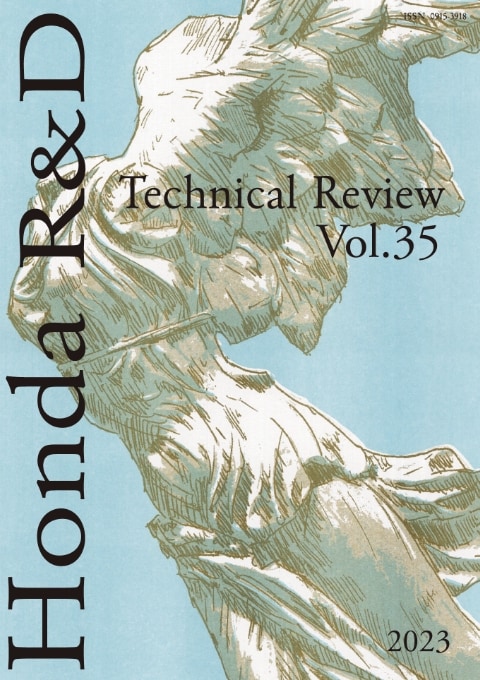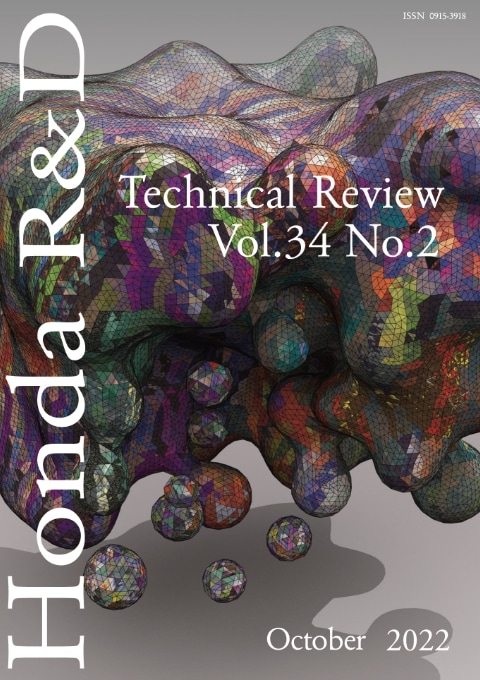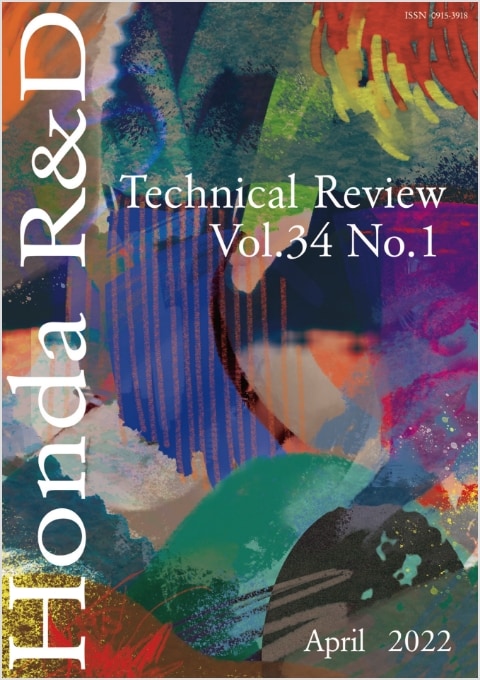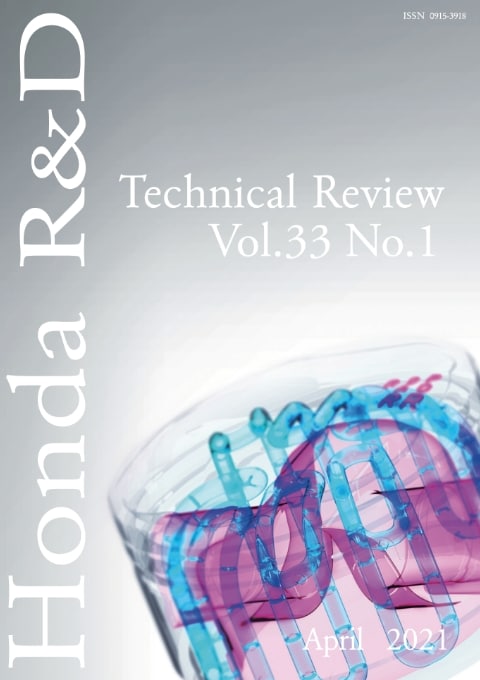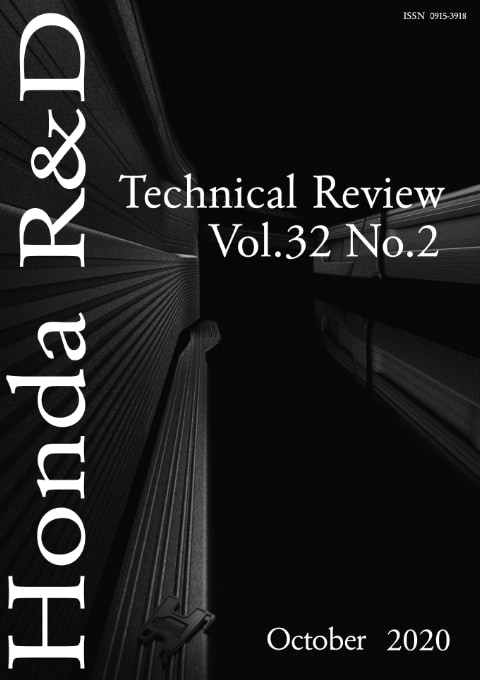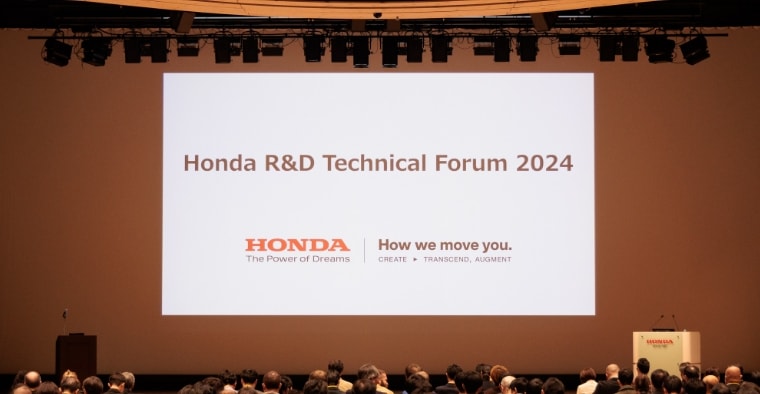Honda R&D Technical Review Vol.34 No.1
Honda R&D
Technical Review Vol.34 No.1
- Styling Design of 2020 H’ness CB350
- Summary
In the Indian motorcycle market, the popularity of 350 cc class mid-sized motorcycles has been increasing since around 2013. A field survey was conducted, and the target users were determined to be young people who are sensitive to changing trends and who adopt global trends. Based on their comments, we decided to use King Riding Position as the keyword. The design was to be based on the concepts of “the rider should look imposing,” “world-class modernity,” and “massive & shaped.” Based on the above, we were able to complete the styling design of the H’ness CB350 in the following manner: it balances the bike firmly supporting the rider confidently straddling it, which is an important value to the Indian customers, and the modernity of the vehicle that evokes global trends.
Yasushi TATEISHI
Details of papers - Development of 2020 H’ness CB350
- Summary
In India since the mid-2010s, middle and large size motorcycles are becoming popular and being enjoyed as a hobby, causing the market of such motorcycles to grow. This development is targeted at such a motorcycle that fills a wide variety of needs from daily use to long tours. In this newly developed model H’ness CB350, the chassis is designed for an upright riding position and a moderate steering response as well as ensuring stability and easy handling. The engine thumps to characterize strength. Another modern convenience is the connectivity that allows stress-free use of smartphone.
Kanta YAMAMOTO、Hidetoshi WAKASA、Takamasa IGUCHI、Takuya OSANAI、Shintaro TESHIMA、Takeyuki KARIYASU
Details of papers - Development of Honda Techmatic System for 2020 Model Year FIT
- Summary
The Honda Techmatic System, a hand-operated driving assistance device that supports the independence of users with physical disabilities, has been developed as an official Honda product for the 2020 model year FIT.
Starting with the 2020 model, a Qi wireless charger for smartphones has been installed in the area where the existing Techmatic control lever is installed. By providing Qi functionality in a Techmatic system vehicle, Honda aimed to reduce the amount of effort required by drivers. Honda was able to continue use of the 2016 model year FIT control lever mechanism by moving it further forward in the vehicle. This compensated for the loss of horizontal space due to the Qi charger and for the installation point loss directly below the control position. In this way, Honda made the control lever mechanism more compact without impacting usability.Takahiko SHIMIZU、Toshihiro KOYAMA
Details of papers - Development of EU3200i Handy Portable Generator
- Summary
The newly developed EU3200i inverter generator of the 3-kVA class provides portability together with the ability to operate a variety of household appliances with leisure applications. The generator adds three key technologies to the 2-kVA class EU2200i to yield higher power output and enhanced usability while limiting increases in size and mass. The first was to mount a dedicated engine and alternator for compactness and high power output, increasing the specific power. The second was the initial adoption of a battery-less fuel injection system in the power product field, realizing simple startup capability while reducing fuel consumption. Finally, the new resin monocoque structure achieves noise levels on a par with previous products while limiting increases in mass. The power-weight ratio has been enhanced 15% over the preceding EU2200i, and with volume of 79 L and mass of 26.8 kg, the generator delivers the highest level of compactness and lightest level of weight in the 3-kVA class.
Masanori TAKEISHI、Hiroshi KOYAMA、Takuo KASE、Yasunori YAMAMOTO、Mitsutoshi HIRATA、Joji MAEDA
Details of papers - Development of 2 kW Class Electric Power Unit eGX
- Summary
The general-purpose GX series engines are installed in a broad range of work machines, serving as power sources for small construction machinery such as tamping rammers and plate compactors. Now, Honda has developed the eGX, a 2-kW-class zero-emission (zero emissions of HC/NOx air pollutants and CO2 greenhouse gas) electric power unit that can replace these engines. The eGX comes in integrated types and separated types, configured for differing work machine mounting conditions and usage environments. Of these, the integrated type was made for replaceability with engines of the same power band. The body size, the shape of the output shaft connected to the work machine, and other aspects are designed for replaceability with the GX engines. Since durability is important for the motor, vibration resistance of 150 m/s2 or more was attained through the rotor shaft support structure and stator connecting structure. Fretting abrasion countermeasures were also implemented. In addition, a sealed motor case was used to provide the water and dust protection required on construction sites, and cooling sufficient for continuous operation at the rated output of 1.6 kW was attained with the use of inside and outside fans.
Fumiyoshi KANBARA、Shunsuke SAWASAKI、Yoshihiko YAMAGISHI、Naoki MATSUNAGA
Details of papers - Development of Anti-vibration Type Brush Cutter for European Commercial Market
- Summary
Honda’s first anti-vibration type brush cutter UMK450E XEET was developed for the European commercial hand-held market. This development established vibration reduction technology by focusing on the shape of the mount rubbers equipped to the anti-vibration frame and the driveshaft bearing placement. The mount rubber shape was newly designed to simultaneously satisfy demands for vibration reduction, swing stiffness during brush cutting work, and actual machine own-weight support. A new bearing placement design method was established that uses the driveshaft as a dynamic damper. This bearing placement design suppresses handle vibration variation due to the static unbalance amounts of the cutting head and the engine flywheel. The newly designed mount rubber and bearing placement realized a low vibration brush cutter that satisfies the user demands in the European commercial market.
Yuki KOIKE、Shingo TSURUOKA
Details of papers - Development of General Purpose Drive Module and Drive Platform
- Summary
A general purpose drive module that consolidates the functions needed for driving, such as drive, steering, and impact absorption, and a drive platform equipped with a cooperative control function that governs the driving functions and is easily connectable to an autonomous drive function were developed. This paper describes the configuration of the drive module, the system configuration of a drive platform consisting of four drive modules, and the steerability achieved by cooperative control. An autonomous delivery robot based on this drive platform was developed with Rakuten Group, Inc. and the effectiveness of the drive platform was confirmed in driving demonstration tests conducted on the University of Tsukuba campus with the support of the New Energy and Industrial Technology Development Organization. Use of this general purpose drive module and cooperative control technology enables the efficient creation of various forms of electric mobility.
Jun ITOH、Yoshinori MASUBUCHI
Details of papers - High Loading Si Anode with 3D Collector and Inorganic Binder
- Summary
The application of three-dimensional collector and inorganic binder for silicon anodes was investigated with a view to raising the energy density of lithium-ion secondary batteries to a high level. In connection with testing, simulations with compact cells were conducted and confirmed the advantage over conventional electrodes in terms of energy density.
The effectiveness of inorganic binder was confirmed using electrodes (density 0.05 g/cm3) fabricated with a loading mass of about 6.0 mg/cm2. It was found that the capacity retention of items without inorganic binder diminished to 25% or less up to the second cycle of the aging process, but the capacity retention of items that included inorganic binder was 78% at 50 cycles. Next, electrode pressing was carried out in order to raise the energy density to a high level. The electrodes obtained in this way (density 0.17 g/cm3 and 0.59 g/cm3) were used to perform the same kind of cycle testing, with the result that while the 0.17 g/cm3 item had the same capacity retention as the unpressed item, the capacity retention of the 0.59 g/cm3 item diminished to 46%. The results from cross-sectional observation of the electrode after testing showed that while the expansion and shrinking of the electrode had been successfully suppressed as anticipated, there were cracks between the interfaces of the composite layer and the collector foil, and the amount of that cracking was confirmed to be greater in the 0.59 g/cm3 item.Toshimitsu TANAKA、Kiyoshi TANAAMI、Yuji ISOGAI、Takashi MUKAI、Yuta IKEUCHI
Details of papers - Investigation of CO2 and Steam Co-electrolysis Conditions for Synthesizing Carbon Recycled Methane
- Summary
An investigation of methane synthesis by co-electrolysis using renewable energy was conducted. The aim was to achieve highly efficient energy conversion in carbon recycling. Specifically, the investigation focused on the reaction conditions that apply when carbon dioxide and high-temperature steam are used to obtain syngas, which is a mixture of carbon monoxide and hydrogen made by co-electrolysis. First, the co-electrolysis performance of the electrolyte supported cell and of the fuel electrode supported cell were compared in order to determine the characteristics of a solid oxide electrolysis cell that are suited to syngas production. It was found from the results of that comparison that both the electrolysis current density and the syngas conversion rate are higher with the fuel electrode supported cell. Next, the relationship between the electrolysis current density and the source gas throughput quantity, which is a design parameter for the solid oxide electrolysis cell reactor, was obtained using a fuel electrode supported cell. Confirmation was also obtained of the source gas composition needed to match the syngas composition to the theoretical molar ratio for producing methane gas, which is an operation criterion for such reactors.
Masahiro MOURI、Kazuki YANAGISAWA、Misato MAKI、Junpei YOSHIDA
Details of papers - Developing Method Using CFD to Design Hydrogen Isolation Structure with Waterproof and Dustproof Filters
- Summary
With a view to still greater compactness and lighter weight in fuel cell systems, a method using computational fluid dynamics was developed to obtain the filter properties necessary to design a hydrogen isolation structure with waterproof and dustproof filters. The filter properties were identified by measuring gas pressure and concentration on both sides of the filter and then using computational fluid dynamics to simulate the measurements to reproduce their content.
The identified properties were confirmed to be versatile and applicable for other initial conditions of gas type, flow, and concentration.
The design method was also validated by comparing the gas concentrations obtained from measurement by a simple testing apparatus to the results of computational fluid dynamics using identified properties. It was confirmed that satisfactory prediction was possible even under conditions of extremely low gas flow.
As a result, a design method using computational fluid dynamics was developed to realize a safer, more compact, and lighter-weight hydrogen isolation structure with filters.Kazuya SASAMOTO、Keisuke SUDA
Details of papers - B-pillar Load Transfer Mechanism in Side Collision
- Summary
Based on side collision testing that the Insurance Institute for Highway Safety in the United States has been conducting, a technology was created that can reduce the amount of B-pillar deformation and also generate a high load. In a side collision, it is necessary for the greater part of the load received from the barrier to be supported by the bending of the B-pillar. This was addressed by creating a new load path in the B-pillar. The new load path is able to support the lateral load input from the barrier as an axial load in a downward direction in the vehicle body. This increases the load from the initial time of collision and reduces bending deformation. A load transfer mechanism in the B-pillar cross-section was added for the axial load and this was realized by a load path to the side sill. The structure of the load transfer mechanism was decided through theoretical calculation and simulation. A prototype was fabricated with a load transfer mechanism in a mass-produced B-pillar. Drop tests with the prototype proved that the load generated on the B-pillar was doubled so that the amount of deformation could be reduced to one-fifth.
Atsushi HASEGAWA、Hitomi YAMADA、Ryotaro TAKEUCHI、Takayuki FUJII、Yumi SAITO
Details of papers - Human Motion Estimation Using Only Inertial Sensors
- Summary
When human motion is estimated using inertial sensors, measurement over long periods of time results in the accumulation of errors in yaw angle direction. There is a method of compensating for this using magnetometers, but this method is not effective in environments where the magnetism is unstable. A method of compensating for errors in yaw angle direction without using magnetometers was therefore investigated. A method was devised in which the measurement object is defined as motion in which every link of the body has the same yaw angle when averaged over time. Compensation is then applied by reducing the differences in yaw angle between the links. When estimating walking motion, the difference in joint angle estimated by the method using inertial sensors and magnetometers and that estimated by optical motion capture has a root mean square of 8.4 deg, while the corresponding figure with the present method using only inertial sensors is 8.9 deg. This indicates equal levels of accuracy. It was also confirmed that the integral calculation error in yaw angle when measuring walking motion over a long period of time was equally reduced.
Haruo AOKI
Details of papers
- About Honda R&D
- Honda Philosophy
- Top Message
- Mission
- Organization
- Company Overview and Affiliates
- Members
- Award
- R&D Research Paper




